#sakkou
Text
Spotlight: The Obi of Sakkō






On The Twelfth Day of Fun I present... another spotlight! Someone actually did an ask about iconic obi, and to me there's no obi more iconic than those worn during the sakkō period.
While the sakkō outfits of each kagai may differ, there's one constant that remains the same: stunning obi with golden threads to celebrate the special occasion. Most tend to have white as a base, but others will incorporate other colors like beige, gold, taupe, or some shade close to gold. In other rare occasions you'll even see bold colors such as green or black; there's no strict rules when it comes to sakkō!
Gold is the color of wealth and celebrations, so its abundance is auspicious and a wish for much luck in the future. The motifs on the obi tend to be auspicious as well, with karabana (imaginary flowers) being quite popular as they're both beautiful and unique as no two designs are identical.
In some cases certain okiya will use the same outfits specifically for their sakkō periods, so we'll see certain obi used just for this period. Sometimes okiya will even use specific obi for specific naming lines if they have more than one under their roof. Other times okiya will choose their finest obi and pair it with their sakkō kimono. The combinations are almost endless and the traditions are unique from one okiya to the next, even within the same district!
Image Credits
Koeri (小衿)
Mamekinu (まめ衣)
Katsuki (勝貴)
Fukusono (ふく苑)
Kanako (叶子)
Tomitae (富多愛)
80 notes
·
View notes
Text
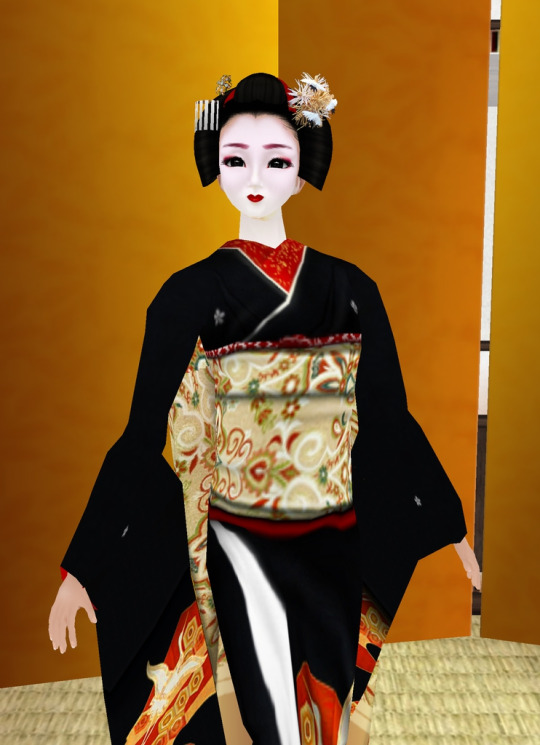

Maiko Mitsuyo performing ''Kurokami'', wearing the sakkou hairstyle and a special kuromontsuki for the end of her apprenticeship.
7 notes
·
View notes
Text
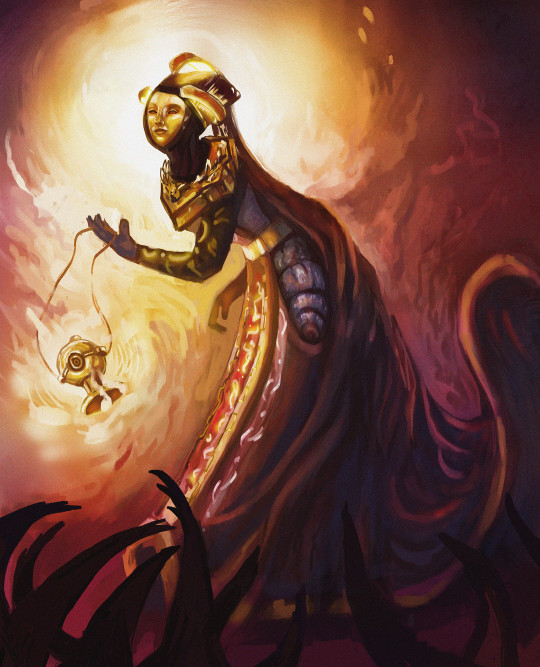
The Eclipse Order - Kris Sakkou
1 note
·
View note
Note
Hi maigeiko! I was recently looking on the akitamaiko.gram account on Instagram, and it would appear that Kanofuji(I believe, bad with names, sorry) is wearing a sakkou like hairstyle? ( src: https://www.instagram.com/p/CkW_zfZBu7S/?igshid=NDk5N2NlZjQ= ). I can’t read Japanese and don’t trust the auto translate feature. Any ideas if it’s for an event or if we’ll behaving an erikae? Thank you!
Hello there! Yes, her name is Kanofuji and she was wearing Sakkô indeed! She and Hanamari celebrated their birthdays and therefore had their own hair in nihongami (they usually wear wigs).
Sakkô as a sign of upcoming Erikae isn't a thing in Akita, as far as I know. But it's definitely possible that Kanofuji will become a Geiko next year!
https://www.instagram.com/p/CkW_zfZBu7S/
6 notes
·
View notes
Text
chinese cities + japanese forenames and cities + theological angels and demons
Aeviro Aichiko Akata Akatsuki Akavang Akayukui Akeika Aking Akino Akitsugan Akoka Aliaoshiko Amashir Amikori Anamameiko Anchaura Angbol Angjiro Aniwaki Araki Arauraizō Arayami Asaki Asasage Ashanmura Astoshōma Asuhi Asussiel Atsuanaru Atsurō Ayansuko Ayuki Azazumiu Azetsukei Azumizutto Badan Batsu Beikadang Beilaphao Betaka Borgo Boriang Bumaga Chalingra Chara Charel Chaumei Chiko Chikuru Chimakas Chira Chirō Chishi Chiyama Clasako Daakasa Daiko Daimi Dazuod Decimi Denkogarie Dogara Duyang Dzonji Ebalamiong Ebinao Eboriko Eijian Emichiran Emoto Endhareng Eritsuki Erurgan Foring Fujinshiro Fukiro Fumakin'yū Fumirō Fusahi Fusaisae Fuzeng Fuzuo Gamoharao Gaoyos Garaichako Gonjōta Gosha Grisa Guilan Gyukioko Haiizō Hakaal Hangko Hanglei Hanojiatsu Hanoshi Haoshuxi Harua Henagawa Henxinao Henzhou Hideming Hideri Hifudihima Higan Higangchou Higerong Higue Himod Hisaiji Hishimi Hishiri Hitsuko Huangde Ichir Ichou Iichi Iichine Imiroe In'yōheshi Irongjian Isangqiu Isaomoel Ishis Itadayua Itoko Itoshi Iwasaka Izhono Izuokazu Izuyasatri Jehou Jiasu Jingta Jophihou Jukou Jurahri Kaddomi Kahian Kaisachika Kaishisra Kakathina Kakatro Kamasu Kamerael Kamichiel Kasang Kashisa Kasukakaya Kataki Katsu Katsuerake Kaurié Kavan Kawasa Kazie Kazuan Kazuguchi Kazusako Kazusuko Kazuyaoyan Kedeyoshi Kehan Keijieshi Kendō Kichi Kichirah Kifriko Kishi Kiyami Koganao Komigeng Kunehi Kurenbei Kures Kureshi Kurochiko Kuzhi Kyori Kyoshi Kyuaichou Kyuke Kyūichiko Kōsuma Kōsōmitsu Laiwa Laiya Langyōhen Lanzuka Lasaki Lechi Leiha Lhajian Liang Lingmeng Linxin Locasaki Locel Maakan Maakeisabu Maezhiko Makeguyuki Malaoki Mamichua Mamieli Masakayugi Masame Masathro Masatsuhi Mashi Mataru Matsuji Meiji Meisaking Mejiake Miche Michi Michikichi Mideching Midemo Migenqaphi Minamaki Minarbin Minjing Minora Misan Miseijiro Mishiko Mitsu Miyashi Miyokubang Miyoshita Mizada Morame Moriories Moter Mothirō Motorumurō Motoyoruhi Motsudai Musang Nabaiwa Nagamejiro Nagashi Nagawa Namtatsuda Namutaga Nanji Naoyahang Naroshi Naruki Naruya Nasuminji Natomoto Natsu Neushi Nihitsu Niige Ningding Nisake Nitoshiro Nobaya Nobuyan Nomuro Norang Noriyanki Obumachi Odaving Ojiangnino Okihigo Omaantaru Oyothanuro Pinaki Poyas Prong Pulsusa Qingzho Qinoruhide Qiqiel Qitsuki Ranangluzō Remoishōgo Renxi Rihen Ritoko Rufujie Rumitong Ryūkihi Ryūseng Sahan Sakazu Sakichira Sakkou Sasiahari Sathi Satsuneya Sedexiang Seihisa Seizhou Shangshi Sharō Shidaoxino Shide Shidehaki Shigen Shigo Shiko Shikou Shiku Shimeizhou Shimi Shimisaki Shimo Shingdi Shinghaizō Shingshi Shiro Shiroki Shiroko Shirokuman Shiromoto Shirō Shisukatsu Shithei Shizept Shizho Shuan Shuatsuyas Shuixiang Shuxinae Siang Simit Suhan Sukaym Sukehi Sukinagawa Suking Sumirō Suyuri Sōgeng Sōjian Tadahiki Tadaikiko Tadayuke Tadetsuo Taichie Tajing Takasuman Takawa Takeki Takimuru Takiya Takiyas Takiyong Takuizō Takunaming Takyōda Takōsu Taravap Tarumbo Tatori Tatsuga Tatsusu Teisawa Teriko Tetadiao Tetakairo Tethi Toakimong Tobei Tokōichie Tomai Tomasuhira Tomichee Tomiyuki Tomohibiel Toshimu Toshinyuan Toyuake Tsuantai Tsugo Tsukiruo Tsunheko Tsuruyunen Tōkan Uozou Uruhikuo Ushimong Ushiro Uzukusas Vachi Vasato Wuyori Xiagao Xianaka Xiaozhang Xichiro Xingqine Xinkilisse Xinobune Xinyasang Yanghae Yanri Yantsuke Yashishiko Yatakiko Yichiko Yidezi Yinaebo Yinang Yinori Yizuo Yokiefume Yomokiya Yonagawa Yoryūshiro Yoshiga Yoshim Yoshon Yosukeishi Yotoakiko Yukefa Yukisa Yumetsukes Yumisuhiko Yuzen Yūgami Yūhen Yūseijō Yūsharō Yūshishiko Yūtako Zaichi Zaoyoshie Zenki Zennitaro Zharu Zhatsuhi Zhoel Zhuisako Ōichi Ōsayose Ōseng Ōsuka
0 notes
Photo
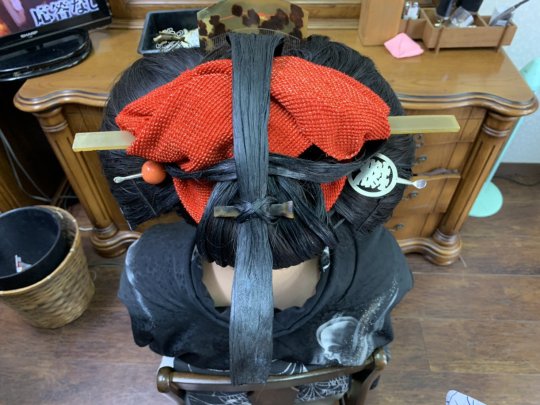
February 2021: In preparation of Setsubun, Aoi-tayuu is wearing the Sakkou (先笄) hairstyle as part of a young wife costume. During the Edo period, the hairstyle was commonly worn by young wives in Kyoto & Osaka as their sign of newlywed status. Maiko of Kyoto adapted the hairstyle as the final style worn prior to their promotion to geisha status; Kyoto’s tayuu also wear a variation of this hairstyle.
Source: https://twitter.com/ayaka8700119/status/1356446632691175425?s=20
#kimono#tayu#tayuu#aoi#aoitayu#aoitayuu#suehiro#suehirookiya#suehiroageya#suehirotayuu#suehirotayu#suehirotimeline#suehiro2021#shimabara#shimabaratayu#shimabaratayuu#setsubun#sakikougai#sakkou
38 notes
·
View notes
Photo


Maiko Umehina during her Sakkou stage
(SOURCE)
375 notes
·
View notes
Text

Umehina’s Sakkō hairstyle 💁♀️
71 notes
·
View notes
Photo







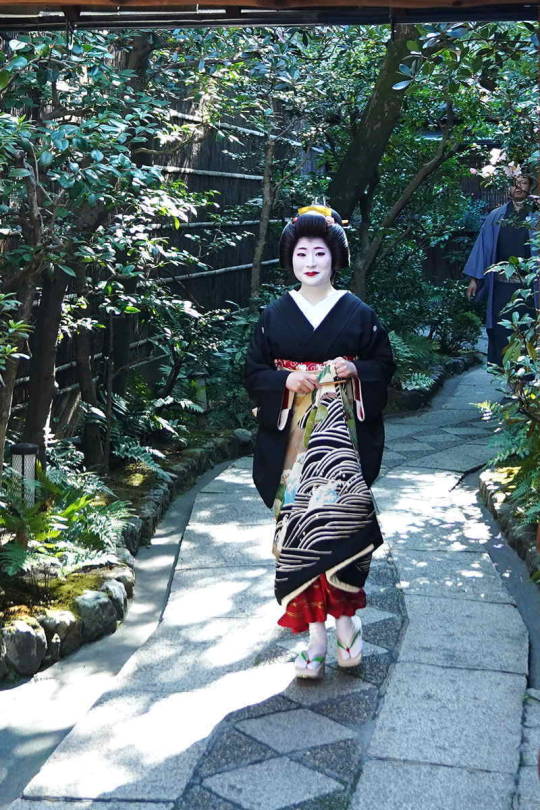

Shino’s timeline:
2014/ misedashi, (Source)
2014/ first-year, (Source)
2015/ second-year, (Source)
2016/ third-year with Marika, (Source)
2017/ fourth-year, (Source)
2018/ fifth-year, (Source)
2018/ sakkou, (Source)
2019/ erikae, (Source)
2019/ as geiko, (Source)
108 notes
·
View notes
Text

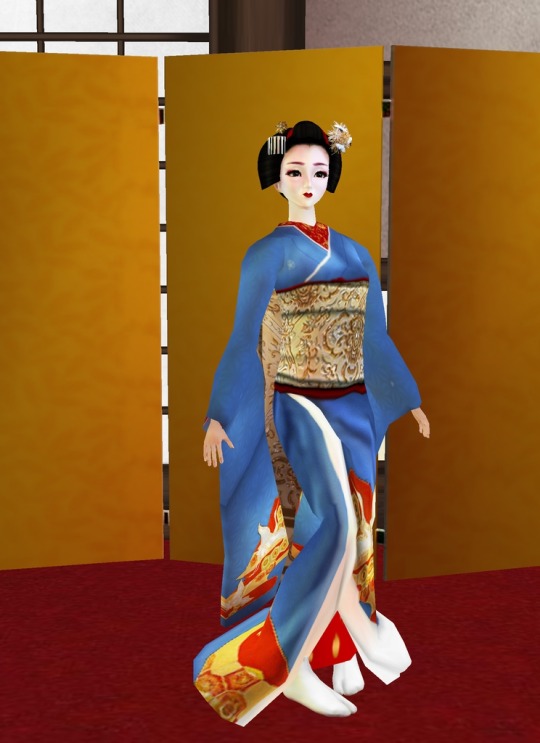


We're happy to announce maiko Mitsuyo is now wearing the sakkou hairstyle, in preparation for her upcoming erikae!
#mitsuyo#hanai#miyajimacho#maiko#geiko#geisha#sakko#sakkou#erikae#imvu#imvu roleplay#imvu products#imvu avatar#kimono#kanzashi
2 notes
·
View notes
Text
I rise from the dead just for this.
Maiko Umehina-san of Umeno is finally wearing Sakkou!!! I hope this means she will actually be having an erikae and isn't just a nicety the okaa-san or Atatori are allowing her to do but omg she looks amazing~
Image is from katufumi on Instagram ^^
Congratulations maiko Umehina-san!!
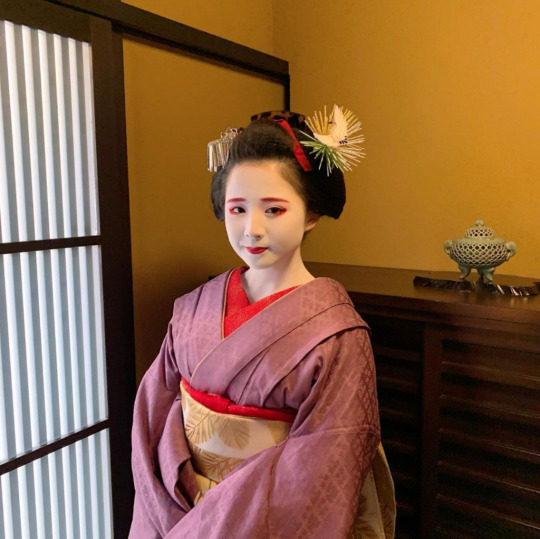
25 notes
·
View notes
Text

May 2019: Maiko Mamesumi (Ninben Okiya) of Gion Kobu performing Kurokami, “black hair”. It’s a special dance that is almost exclusively performed during a Maiko’s sakkou period.
A “sakkou period” are the two to three weeks before a Maiko has her Erikae and becomes a Geiko. She wear the special, elaborate sakkou hairstyle (very well visible in the picture above), and wears a special, self-designed kanzashi consisting of lucky motifs. They also wear special outfits, but those depend on the customs of the kagai. In Gion Kobu, Maiko wear a formal black kimono, a golden obi and a mostly white collar.
At the end of their sakkou period, the end of the girl’s bun is symbolically cut off to signify her transition from Maiko to Geiko, from girl to woman.
Mamesumi's Erikae will take place on the 30th of May! It's the first Erikae from Ninben/Shibata since Mamesome's in February of 2013.
Source: takutanimoto on Instagram
#mamesumi#ninben okiya#gion kobu#kimono#hikizuri#furisode#susohiki#obi#darari obi#obiage#kuromontsuki#oshiroi#makeup#sakkou hairstyle#sakkou#hairstyle#hair#kanzashi#daikin#maezashi#hairpin#hair ornament#comb#kushi#geisha#maiko#geigi#geiko#nihongami#geisha makeup
130 notes
·
View notes
Photo

May 20th, 2018: Radiant maiko Tomitsuyu (富津愈) of Tomikiku okiya in Gion Higashi dancing during her sakkou period. She is now a successful geiko!
From the 55Maiko Facebook Page.
25 notes
·
View notes
Photo

ตุลาคม 2560: ไมโกะ Mikako (โอกิยะ Nishimura) จากเขต Gion Kobu ในผมทรง Sakkou และเครื่องประดับผมแบบพิเศษเฉพาะช่วงก่อนเลื่อนขั้นเป็นเกโกะเท่านั้น
Sakkou (先笄) เป็นชื่อทรงผมทรงหนึ่งที่ไมโกะจะทำเป็นทรงสุดท้ายก่อนได้เลื่อนขั้นขึ้นเป็นเกโกะเต็มตัว กล่าวคือไมโกะจะทำผมทรง Sakkou ด้วยผมจริงของเธอ เป็นเวลา 2 สัปดาห์ก่อนเข้าพิธีเปลี่ยนปกกิโมโน (衿替え: Erikae) ซึ่งทรงผมญี่ปุ่นโบราณทรงนี้เป็นทรงที่ซับซ้อน สวยงาม และทำยากที่สุดของไมโกะ มีการประดับผมทรง Sakkou นี้ด้วยเครื่องประดับที่ทำจากกระและ Kanzashi พิเศษที่ไมโกะคนนั้นออกแบบเอง โดยมีรูปแบบทั่วไปคือสัตว์มงคลเช่นกระหรือนกกระเรียน
Source: ei88 on Exblog
9 notes
·
View notes
Photo







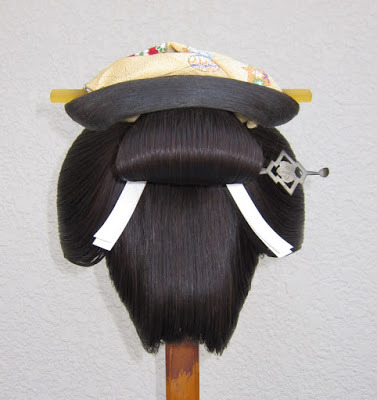

Source: http://nihongami.blogspot.com/2017/11/blog-post_19.html
Japanese Hairstyles: Historical Overview Part 02: Women’s Hairstyles of the Edo Period, Part 03
Hairstyle Name: Hashinashi no Warikkou (Sakkou) [ 橋なしの割っこう (さっこう) ] lit. “Split Hairpin without Hair Bridge (First Hairpin)”
This hairstyle appears to be a variation of the Sakkou hairstyle that doesn’t include the hashi (hair bridge) over the chirimen topknot. This would have been worn by married middle-aged (between the ages of 45-65) women in the Kyoto-Osaka (a.k.a. Kansai) region. Knowing that the sakkou (先笄) was a hairstyle worn by newly-wedded women in the region, it seems like a natural progression that it would somehow be modified to indicate a long marriage.
#kimono#nihongami#edonihongami#nihongamitimeline#nihongamitimeline03#nihongamitimeline03e#edo#edoperiod#sakkou#hashinashinowarikkou#hashinashi#warikkou
121 notes
·
View notes
